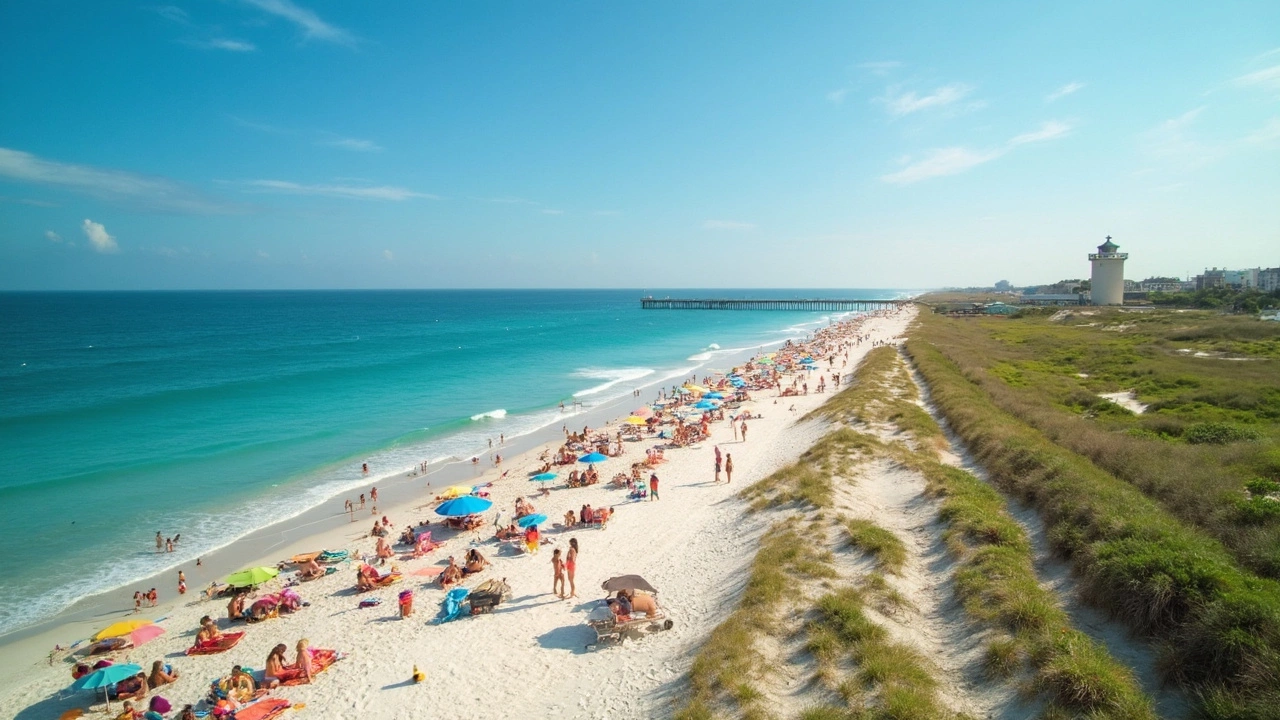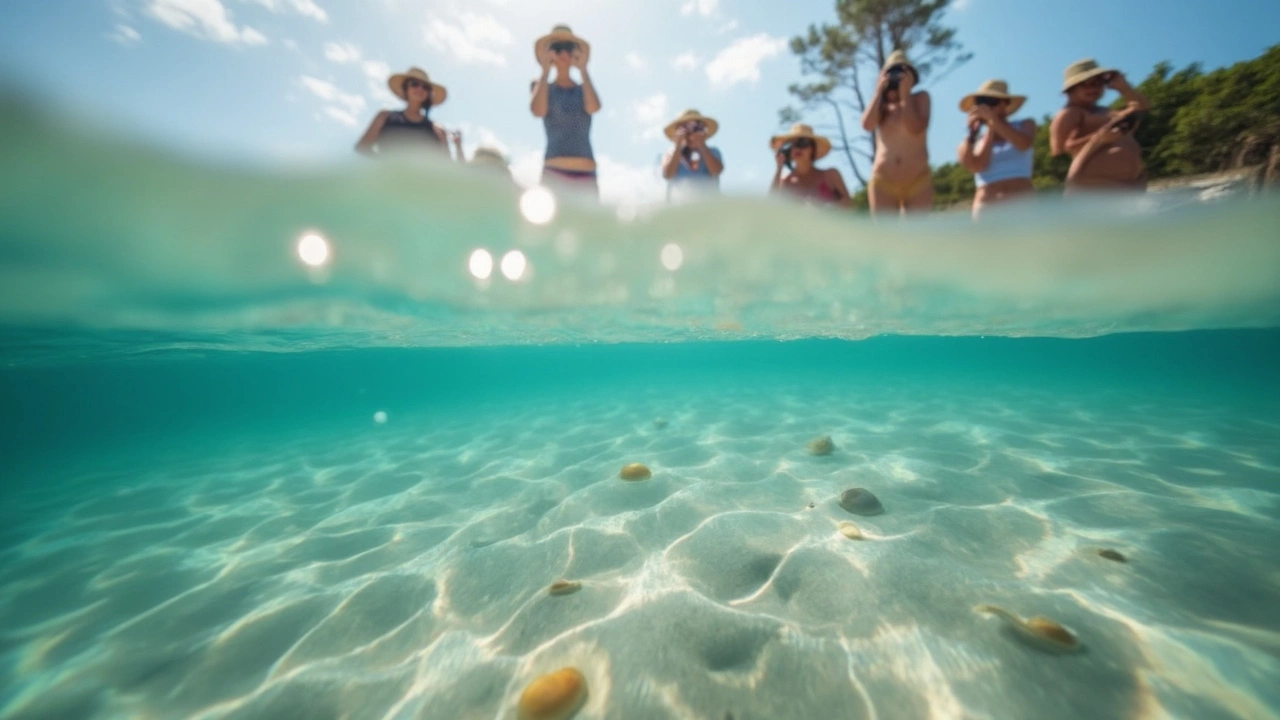Bluest Water in South Carolina: Where to Find It
 May, 15 2025
May, 15 2025
If you imagine South Carolina beaches and think murky brown water, you're not alone—but you're missing out. There's actually a stretch of shoreline here where the water can look downright Caribbean blue, at least on the right day. People are always searching for the spot with the clearest, bluest water, especially for Instagram shots or just to dip your toes into something that feels extra special.
The bluest water in South Carolina? It's usually found at Hunting Island State Park, just outside Beaufort. Locals swear by it, and even longtime visitors to Myrtle or Hilton Head admit the color here is next-level. The ocean is a lot clearer at Hunting Island because it's a bit separate from big cities and development, so less runoff clouds things up. The sand is lighter too, which makes the water look brighter. Hunting Island's not just pretty, it's got a bit more wild vibe, so you get more nature and less crowd.
- Why South Carolina's Water Varies So Much
- The Beach With the Bluest Water (And Why)
- Best Times to Visit for Clear Blue Water
- Tips for Making the Most of Your Beach Day
Why South Carolina's Water Varies So Much
If you've ever noticed that some beaches in South Carolina are crystal clear while others seem murky or brown, there's a real reason for it. The color and clarity of the water depend on a bunch of natural factors, not just luck or location. One major thing is river runoff—South Carolina has a few big rivers, like the Santee and Edisto, that empty out right along the coast. After heavy rain or storms, these rivers send a ton of sediment and even bits of plants out to the beaches closest to them. That stuff clouds the water, making it look brown or muddy even if it's perfectly safe for swimming.
Tides matter too. When the tide goes out, you get more mixing with sand and silt, which turns the water cloudy. When tides are high, the water can seem cleaner, especially if there hasn't been a recent storm. Another biggie is human activity. Busy resort towns like Myrtle Beach sometimes get extra runoff from parking lots, roads, and lawns, so the water doesn't get that classic "blue" look as often as you'd hope.
Check out these quick facts on what affects beach water in SC:
| Factor | Impact on Water Clarity |
|---|---|
| River Runoff | Makes water murkier after heavy rain or storms, especially near river mouths |
| Tide Levels | High tide often means clearer water; low tide usually looks cloudier |
| Location | Beaches with less development or marshes usually have clearer water |
| Human Activity | More buildings and roads = more runoff and cloudy water |
| Sand Color | Lighter sand reflects light, making water seem more blue |
So, if you're hunting for the bluest water South Carolina has to offer, keep these points in mind. Stick to beaches farther from the big rivers and watch for days after a spell of dry weather. Trust me, you'll see a big difference just with a little timing and choosing the right spot.
The Beach With the Bluest Water (And Why)
When people start digging into the best bluest water South Carolina experiences, almost everyone in the know points straight to Hunting Island State Park. It's not just hype—there’s real science and geography behind the color of the water here. Hunting Island sits about 16 miles east of Beaufort, and it avoids a lot of pollution, big crowds, and heavy boat traffic that other beaches get swamped with. You get a mix of clear Atlantic water and very little urban runoff. The result? Water that can look shockingly blue, especially from late spring to early fall.
Here’s what actually makes Hunting Island’s water stand out:
- Light, sandy bottom: The sand here is a lot whiter than the muddy, dark sand you’ll see at Myrtle Beach or Folly. That bright bottom reflects sunlight, which makes the water pop with blue and turquoise shades.
- Minimal development: Because it’s a protected state park, you don’t get a ton of hotels, shops, or roads nearby. That means less storm runoff and pollution getting into the waves.
- Barrier island location: Hunting Island juts a bit farther out into the Atlantic than a lot of other beaches, so it gets more "fresh" ocean water rolling in with every tide.
If you like stats, the water here consistently tests among the cleanest in South Carolina. According to 2024 state health data, Hunting Island’s water averages a bacteria count well below EPA standards for safe swimming (usually below 20 cfu/100mL in summer, which is way healthier than busier beaches that sometimes hit 60+).
| Beach | Avg. Bacteria (cfu/100mL, Summer 2024) | Typical Water Clarity |
|---|---|---|
| Hunting Island | 18 | High |
| Myrtle Beach | 56 | Medium |
| Folly Beach | 42 | Medium-Low |
The wild vibe at Hunting Island also means you might see dolphins, sea turtles, and flocks of pelicans cruising by while you swim or walk the pier. The state park also limits how many people are allowed in during peak season, so it never feels overrun. The only real downside? The facilities are basic, and you’ll want to bring your own snacks, chairs, and umbrella. But for a day spent swimming in the bluest water in South Carolina, the trade-off totally pays off.

Best Times to Visit for Clear Blue Water
There’s actually a trick to catching that perfect blue water vibe on South Carolina’s coast—and yes, it changes with the seasons. If you want to see the bluest water South Carolina has to offer, you’ll need more than luck.
The clearest water usually shows up in late spring (April to early June) and early fall (September to early October). Why? It comes down to three things: less rain, fewer crowds stirring up sand, and cooler temps cutting down on algae and runoff. Summer brings more people, storms, and muddy river runoff, which makes the water look cloudier.
Pay attention to the weather, too. After heavy rain, the water turns darker and murky for a few days because rivers wash stuff into the ocean. Aim for a stretch of sunny days—especially after a dry spell. Even wind matters! When the ocean’s calm and the wind’s light, the water stays clear. During high tide, Hunting Island’s blue really pops because less sand is kicked up compared to low tide.
- Check tide charts—high tide usually means cleaner, bluer water.
- Go early morning or late afternoon for the best color and perfect photos (plus, fewer people).
- Weekdays are way quieter than weekends, so the water gets less stirred up.
Here’s a quick cheat sheet:
| Month | Water Clarity | Temperature |
|---|---|---|
| April | Great | Low 70s °F |
| May | Excellent | Upper 70s °F |
| June | Good (watch for crowds) | Low 80s °F |
| September | Excellent | Low 80s °F |
| October | Great | Mid 70s °F |
If you're a sunrise person, get to the beach just after dawn—you’ll see almost glassy water and sometimes catch dolphins swimming nearby. Night owls can stick around for sunset, when the water picks up some cool colors. But skip it after a big thunderstorm—the ocean will need a couple days to clear up.
Tips for Making the Most of Your Beach Day
Planning ahead makes a huge difference if you want to get the ultimate experience at Hunting Island or any other spot with the bluest water South Carolina can offer. Here’s what you actually need to know:
- Go early or go late. The water looks clearest and calmest before lunch or close to sunset. Plus, there are fewer crowds and less glare, which means your photos pop and you score a better spot on the sand.
- Check the tides. Aim for mid-tide or lower. When the tide is out, the sand reflects more light up into the water, making the blues look even brighter. Local tide charts (easy to google) are your friend.
- Watch the weather. Sunny, cloud-free days are best for that bright Caribbean-blue vibe. A bunch of rain right before your trip can kick up silt and make things murkier, so try to go after a string of dry days if water color really matters to you.
- Pack for a state park. When you visit Hunting Island, bring everything you want for the day: snacks, water, sunscreen, and a good cooler. There’s not much in the way of stores once you’re on the island. Bonus: pack a trash bag so you can leave your spot cleaner than you found it.
- Bring your best gear. Want to really see that blue water? Polarized sunglasses make the color pop. A waterproof case for your phone or camera is a small investment if you want the perfect shot in the surf.
- Respect the wildlife. Hunting Island is full of critters you won’t see on busier beaches—dolphins, blue crabs, even the odd loggerhead turtle. Keep your eyes open and your distance if you spot wildlife. Leave sand dollars, shells, and starfish where you found them so others can enjoy them too.
If you’re going on a busy weekend between May and September, parking fills up fast. Parking lots at Hunting Island State Park often reach capacity by 11 a.m., so aim to get there before 10 a.m. to save yourself the hassle. Don’t forget there’s a park entrance fee, so bring some cash or your park pass.
One last thing: cell service is spotty on the island, so if you’re meeting friends or family, set a meetup spot beforehand. With these tips, you’ll get the most out of your day and soak up that rare blue water South Carolina has to offer.
